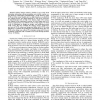Free Online Productivity Tools
i2Speak
i2Symbol
i2OCR
iTex2Img
iWeb2Print
iWeb2Shot
i2Type
iPdf2Split
iPdf2Merge
i2Bopomofo
i2Arabic
i2Style
i2Image
i2PDF
iLatex2Rtf
Sci2ools
78
Voted
DATE
2010
IEEE
2010
IEEE
Energy- and endurance-aware design of phase change memory caches
—Phase change memory (PCM) is one of the most promising technology among emerging non-volatile random access memory technologies. Implementing a cache memory using PCM provides many benefits such as high density, non-volatility, low leakage power, and high immunity to soft error. However, its disadvantages such as high write latency, high write energy, and limited write endurance prevent it from being used as a drop-in replacement of an SRAM cache. In this paper, we study a set of techniques to design an energy- and endurance-aware PCM cache. We also modeled the timing, energy, endurance, and area of PCM caches and integrated them into a PCM cache simulator to evaluate the techniques. Experiments show that our PCM cache design can achieve 8% of energy saving and 3.8 years of lifetime compared with a baseline PCM cache having less than a hour of lifetime.
Related Content
| Added | 10 Jul 2010 |
| Updated | 10 Jul 2010 |
| Type | Conference |
| Year | 2010 |
| Where | DATE |
| Authors | Yongsoo Joo, Dimin Niu, Xiangyu Dong, Guangyu Sun, Naehyuck Chang, Yuan Xie |
Comments (0)

